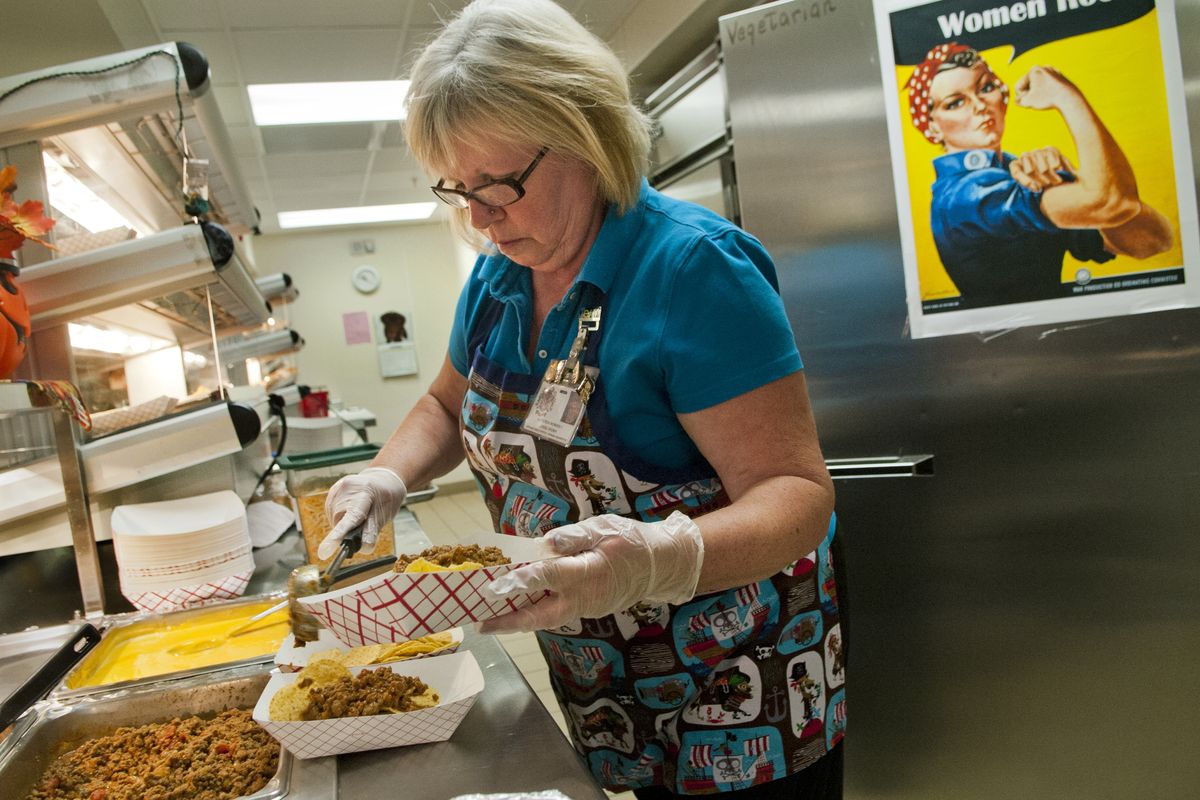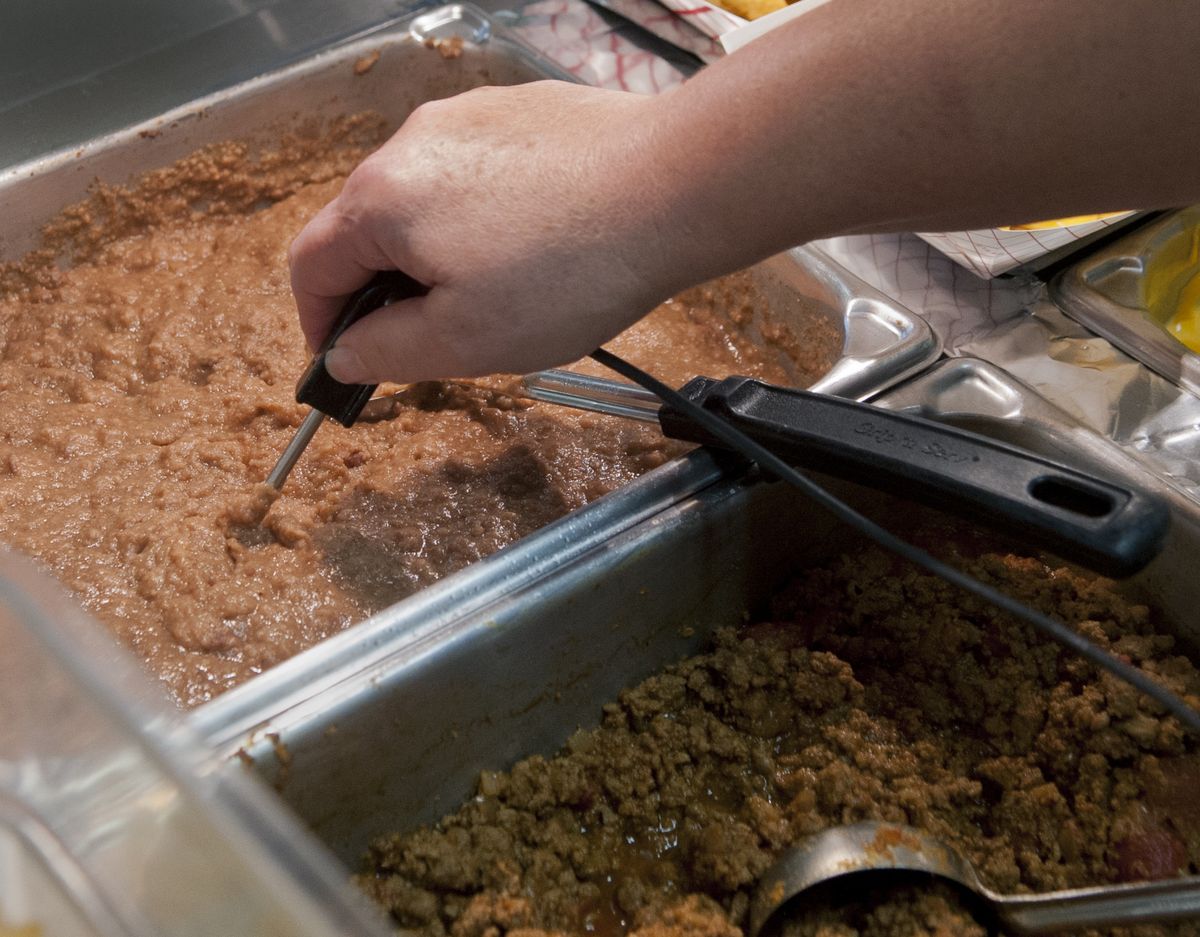School cafeterias may be among the best places for kids to eat
Washington state inspection reports show food safety is paramount
Rogers High School food worker Denise Brown prepares servings of nachos for students during the lunch hour on Oct. 4. (Dan Pelle)Buy a print of this photo
School cafeteria kitchens in Washington serve about 500,000 lunches a day. Most of that food isn’t prepared from scratch, although there’s a growing movement to bring scratch cooking to public schools. Still, given that volume, you might expect school kitchens to rack up a fair number of health department violations.
A Spokesman-Review database of school cafeteria inspection reports finds that the opposite is true. There were only 521 citations in three years in Washington’s 295 school districts, in which there are more than 3,000 schools.
Mouse infestations, mold, expired food and kitchen staff using their bare hands to prepare food for K-12 students were among the worst violations found in Washington’s school kitchens between 2010 and 2012, the database shows.
However, about 25 percent of school kitchens are not inspected twice a year as required by the U.S. Department of Agriculture – including schools in Spokane and King counties. Responsibility for that rests primarily on the shoulders of the county health agencies, which conduct the inspections.
“Right now, the conversations we’ve had are they don’t have the staff,” said Doug Wordell, Spokane Public Schools’ nutrition services director. “But if they want to (do twice-yearly inspections), we say: please come.”
Spokane County health officials say school kitchens are only inspected once a year because they are considered low-risk.
“We prioritize our inspections based on risk,” said Ray Byrne, Spokane County Regional Health District food safety program manager. “The menus that schools serve are not high-risk because they are mostly prepackaged and pre-prepared.”
What’s more, there’s no real penalty for not complying with the twice-yearly inspection requirement.
Although the government has the ability to withhold funding if a school district fails to have two inspections, that hasn’t ever happened, said a USDA spokeswoman.
“I’m not real concerned about it; schools are run safely,” said David Gifford, Washington state Department of Health food safety director.
Smaller districts have worst violations
The state’s school kitchens are held to the same health code standards as restaurants, even though they serve significantly more meals per day.
The state’s roughly 270 McDonald’s restaurants, for example, serve about 270,000 meals per day.
Overall, most schools have clean, safe kitchen operations, the 4,500 pages of inspection records used to compile the database show.
Despite their relative scarcity in school kitchens, food-handling violations are of great concern to public health officials, said Gifford, of the state health department.
“It is, both nationally and in Washington, the No. 1 cause of foodborne disease,” Gifford said. “Norovirus doesn’t come from improper cooking; it comes from people not washing their hands.”
Inspectors found workers not using gloves or not properly washing their hands in several locations, including in the Lake Washington, North Beach, Toutle Lake, Columbia, Vancouver, Cape Flattery, Cascade and Kennewick school districts.
Smaller districts tended to have the more egregious violations: rodent problems; food handlers not wearing gloves or not washing their hands; or, in one case, pink mold found in an ice machine.
Violations among the larger districts were usually for things like faulty equipment, improper food-holding temperatures, expired food worker cards or too little or too much bleach in sanitizing water.
Schools in Garfield and Mason counties had zero violations in three years, documents show.
“Schools are low-risk; the workers are well trained and committed,” said Wordell, of Spokane Public Schools. “Schools are the safest place kids eat.”
‘We take it very, very seriously’
Health inspectors found 30 violations in Spokane County’s 150 schools last school year, documents show.
Twelve were found in Spokane Public Schools, the state’s second-largest school district.
Among them: Not all kitchen staff at Hutton Elementary had their food cards available to show the inspector. The wrong sink was used to pour off liquid from cooked meat at Jefferson Elementary. There was too much bleach in the sanitizing buckets at Garry Middle School. Salad tongs were lying in the salad at Logan Elementary School. Individual cups of tartar sauce were uncovered on a food-serving table at Wilson Elementary School. Apples were washed with the stickers on at Roosevelt Elementary.
Similar violations were found in Cheney, Medical Lake, Central Valley, West Valley and East Valley school districts.
Mead School District only had one violation: tongs sitting in the lettuce on a salad bar.
“We ask our workers: Which one of you wants to send a kid to the hospital? The answer is nobody,” said Wordell. “We take it very, very seriously.”
Diane Hardesty, Rogers High School’s kitchen manager, wasn’t surprised to hear some of the more serious health violations had occurred in smaller schools. Larger districts offer frequent training and support, she said.
Hardesty’s staff hustled around Rogers’ kitchen preparing for the lunch rush recently. They checked the temperatures of refried beans, pizza, sandwich wraps and the cheese for nachos as they put the items out.
“The steps they (kitchen staff) take every day are what inspectors check annually,” said Hardesty, who has worked in Spokane Public Schools kitchens for 33 years. “We talk about that. We need to be ready for an inspection every day.”
Once a week, employees take turns doing quality reviews on food storage and sanitizer bleach levels.
The temperature is logged daily in a large cooler where dairy is kept.
Hardesty said that log saved her when five kids got sick after drinking milk one day. She knew the temperature was right and the milk wasn’t past its expiration date.
She added, “It would be my worst nightmare to have my name in the paper because a kid got sick in my kitchen.”
Violations run the gamut
Health inspectors found mold in kitchens at Deer Park Middle School, in the Camas and Oak Harbor school districts and in a private school in Tacoma. Mildew was found in a dishwasher at Pullman High School.
Mice droppings were found twice at New Horizons High School in the Pasco School District. A dead mouse was found in a trap at a high school in the Longview School District, and Lincoln County’s Harrington School District and Olympia School District had mouse infestations. Coffee carafes were being stored in a bathroom at Bellingham High School, a report noted. A two-inch straight pin was found in with rolls at Vancouver Arts & Academics.
Those types of violations were rare, documents showed.
The more common violations included some of the same things that cropped up in Spokane: cooked food not kept hot enough or cold foods not cold enough; too little or too much bleach in cleaning water; faulty equipment or a lack of the right equipment; and staff with expired food-worker cards.
Numerous school districts statewide had one or more of those violations, but health authorities said they’re easily fixed.
Gifford noted that food kept lower than the proper temperature for more than two hours increases the chance of food-borne illness, but the window for school lunches is usually shorter than two hours, so even when food slips below temperature it’s not out long enough to be dangerous.
“In terms of risk, things that are not cooked properly are a higher risk,” Gifford said. “If it’s cooked properly, there are no diseases to start with.”
Inspectors did not find any food that hadn’t been cooked properly in Washington’s schools, documents showed.

